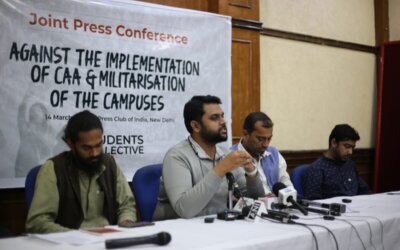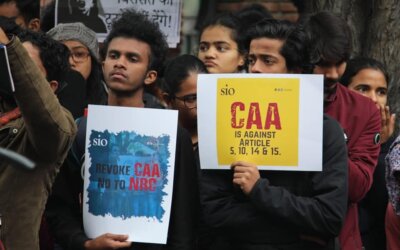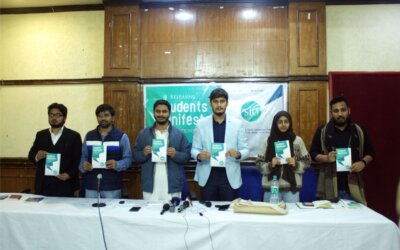New Delhi: In May 2019, the Union Ministry of Human Resource Development (HRD) had released a draft of the proposed New Education Policy, prepared by a committee under the chairmanship of Dr. K. Kasturirangan, for public consultation. Subsequently, Students Islamic Organisation of India (SIO), in collaboration with Centre for Educational Research and Training (CERT), submitted to the ministry a detailed analysis of the policy, in which concerns were raised about centralisation, commercialisation and saffronisation of education under the new regime. The organisation also gave a number of recommendations for improving the draft. This intervention by SIO, and possibly other individuals and organisations, resulted in several positive changes – at least 15 – in the final National Education Policy (NEP), approved by the central cabinet in July 2020. Here’s a look at these improvements:
1. URG Replaced with SEDG
Draft NEP 2019 had clubbed all the sections of the society deprived of equitable education under an umbrella term ‘Under-Represented Groups (URG)’. SIO objected to the term, arguing that it presumes homogeneity even though the groups it addresses have a diversity of causes for their marginalisation. The term ‘URG’ also carries a pronounced predisposition for inadvertent discrimination. In the final NEP 2020, URG was replaced with Socio-Economically Disadvantaged Groups (SEDGs), with proper categorisation of these groups based on their gender, socio-cultural and geographical identities, disabilities as well as socio-economic conditions.
2. Parents’ Role in Curbing Dropouts Recognised
In Draft NEP 2019, parents didn’t have any role in bringing dropouts back to the school system. SIO insisted that parents should be involved in the education process by including them in School Management Committees (SMC) and forming Parent-Teacher Associations (PTA) to improve enrolment rates and prevent dropout of students. Later, in final NEP 2020, parents were given a prominent role in engaging with communities to ensure that all school-age children are attending and learning in school. The final policy also recognised parents’ role in school governance and SMCs.
3. Legal Education Delinked with Mythology
Draft NEP 2019 emphasised on the need to connect the legal education with ‘culture and tradition of the people’ and invoking ‘victory of Dharma over Adharma writ large in Indian literature and mythology’. SIO contended that, in the name of contextualizing legal education, this a concerted effort to reshape legal education in the mold of the mythology and specific religious traditions of one community. The final NEP 2020 omitted these phrases and restricted to ‘the curricula for legal studies must reflect socio-cultural contexts.’
4. No Reservation Exemption for Private HEIs
Draft NEP 2019 had exempted private higher education institutes (HEI) from some of the reservation guidelines for public institutions. SIO demanded that the reservation must be extended to private HEIs as well, along with financial aid and reduced fees for students under reserved categories. The final NEP 2020 established that all HEIs – public and private – will be treated on par within this regulatory regime.
5. Role of NRF Diminished
Draft NEP 2019 had proposed setting up of a National Research Foundation (NRF) as a central agency to fund, mentor, incentivise, and build capacity for quality research. SIO argued that there is no evidence to show that a centralised funding and monitoring body will necessarily improve the quality of research in India. Subsequently, the final NEP 2020 said that the institutions that currently fund research at some level will continue to do so according to their priorities and needs, while NRF will merely coordinate with other funding agencies and academic institutes.
6. NRF Freed from Political Influence
Under Draft NEP 2019, the NRF was to be constituted under Rashtriya Shiksha Aayog (RSA), which would be headed by the central government. SIO objected to this policy, saying that the proposed should be an autonomous body and not intricately linked to the priorities of the government of the day. As a result, the final NEP 2020 assured that the NRF will be governed, independently of the government, by a rotating Board of Governors.
7. Government-Controlled RSA Scrapped
Draft NEP 2019 proposed setting up a new apex body for education named Rashtriya Shiksha Aayog (RSA), which would be chaired by the prime minister. SIO demanded that RSA be scrapped because the body was expected to fall prey to the political expediency of the Prime Minister’s Office, while it also threatened to adversely impact the federal structure of education in India. The final NEP 2020 has no provision for RSA.
8. Provisions for Access and Equity in Higher Education Added
Draft NEP 2019 had no specific provision for access and equity with respect to higher education. SIO opined that the plan the aim of increasing enrolment in higher education institutes cannot and should not be pursued without addressing the issues of access, equity, drop-outs, and the regional disparity of educational institutions. Consequently, an entire chapter related to access and equity in higher education was added in the final NEP 2020. The policy recognised that there are certain facets of exclusion, that are particular to or substantially more intense in higher education and provided a list of measures to address them.
9. Schools No Longer Free to Set Their Fees
Draft NEP 2019 allowed private schools to set their own fees and had vague provisions about ‘public scrutiny’ and ‘reasonable increase’ of fees. SIO countered that allowing schools to set their own fees creates immense scope for misuse. This provision was later removed in the final NEP 2020.
10. No Financial Autonomy for HEIs
Draft NEP 2019 had provided that higher education institutes (HEIs) will gradually move towards full autonomy – academic, administrative, and eventually financial. SIO said that financial autonomy must go hand in hand with transparency, oversight, and democratic decisionmaking process to prevent the possibility of commercialisation. The final NEP 2020 did away with financial autonomy, restricting to academic and administrative autonomy only.
11. Fees Capped
Draft NEP 2019 had no mention of any upper limit on fees. SIO wanted that the regularisation of educational institutions in terms of licensing and fee-capping against exorbitant fees/donations must be ensured so that exploitation of students is prevented, and education is accessible to all. So, the final NEP added a provision for transparent mechanisms for fixing of fees with an upper limit.
12. Bridge Courses for SEDGs Introduced
Draft NEP 2019 had no mention of any bridge courses to integrate students from disadvantaged groups in the education system. SIO suggested that proposed Madrasa boards should design bridge courses to facilitate entry of madrasa graduates into higher education institutes (HEIs). The final NEP 2020 says that alternative forms of schools, including madrasas, will be supported to integrate the subject and learning areas to eliminate the underrepresentation of children from these schools in higher education. It also mentioned bridge courses for all socio-economically disadvantaged groups (SEDGs) to facilitate their entry into higher education.
13. Scholarship System to be Improved
Draft NEP 2019 had no mention of the National Scholarship Portal (NSP) and the issues associated with it. SIO pointed out that the scholarships offered by the union and state governments are encumbered by several issues and advocated for easing and streamlining the entire process. The final NEP 2020 provides that the NSP will be expanded to support, foster, and track the progress of students receiving scholarships.
14. Vocational Education No Longer A ‘Second-Chance’ Alternative
Draft NEP 2019 had relegated skill development and vocational education as ‘second chance educational opportunities’ for those who ‘fall behind’. SIO objected, offering that the vocational education and skills training must not be conflated as an alternative to comprehensive education under the common schooling system. Instead, it should be included in the curriculum at all levels of education. The final NEP 2020 is aimed at overcoming the social status hierarchy associated with vocational education by integrating it into mainstream education in all institutions and at all levels in a phased manner.
15. NRED Binned Owing to Privacy Concerns
Draft NEP 2019 proposed that all records related to institutions, teachers, and students will be maintained by a single agency in digital form in a National Repository of Educational Data (NRED). SIO insisted that no plans for storage or usage of such personalised data should be made before a clear and unambiguous privacy regime is put into place. There is no provision for NRED in the final NEP 2020.




0 Comments